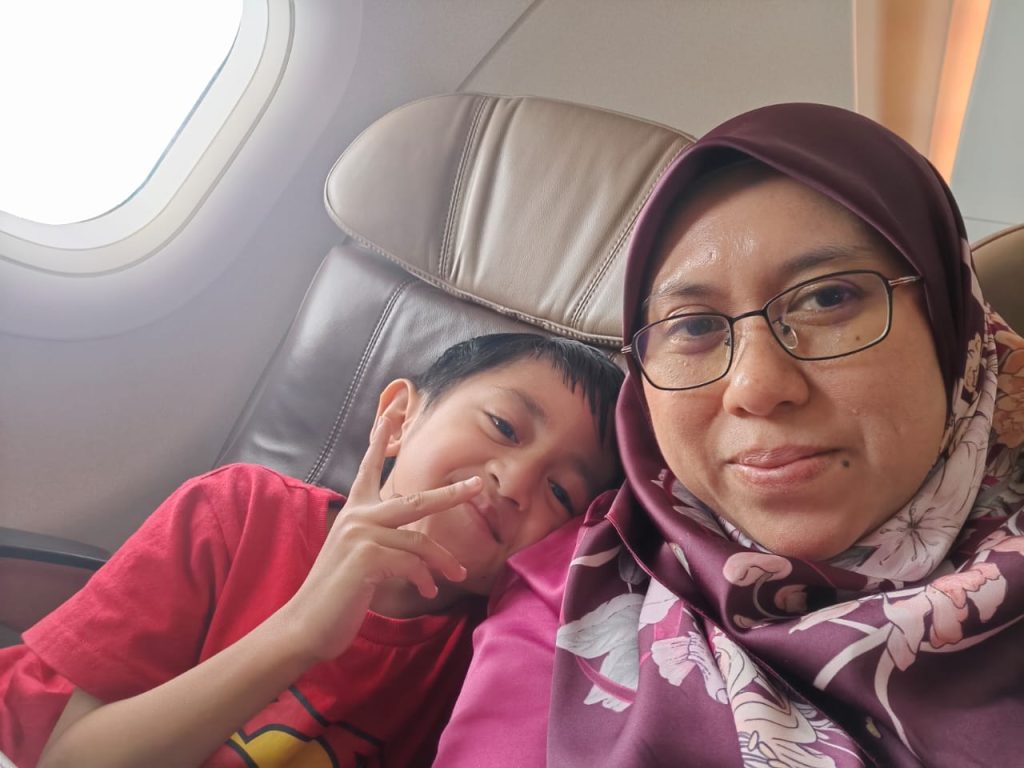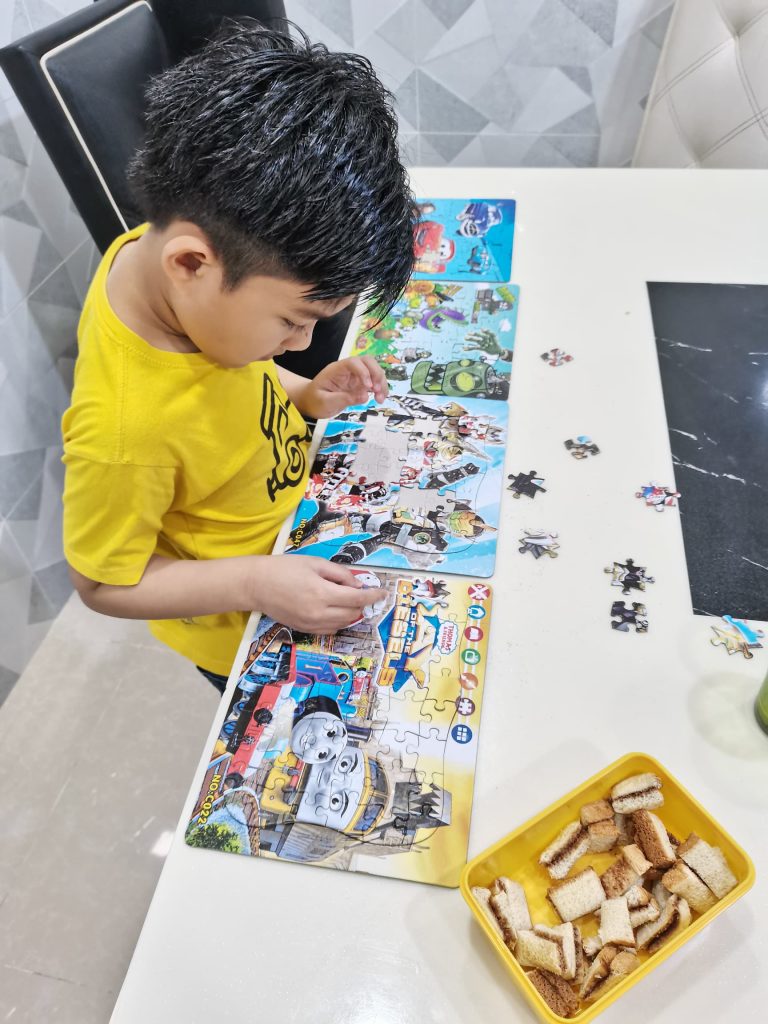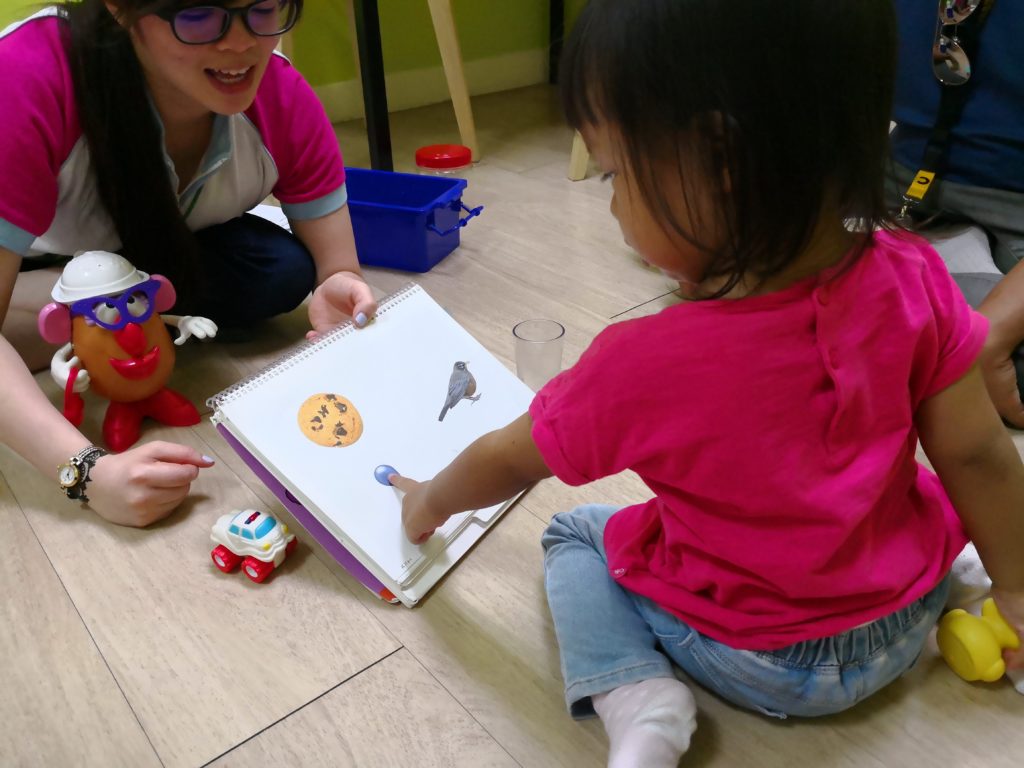It took time for Atilah bt Mohamed to accept that her precious firstborn, Muhammad Iman Ismail, might be autistic. Even now, it’s a realisation she’s still learning to embrace. Born with Osteogenesis Imperfecta – a brittle bone condition, Iman’s survival was the first battle. Autism was another unexpected layer.
Atilah initially thought Iman’s preference to play alone or his struggle to make friends in kindergarten was because he needed to avoid rough play. He could speak and make eye contact, unlike the textbook image of autism she had in mind. But there were signs: repeated questions, explosive reactions to his younger sister, moments that puzzled her.
It wasn’t until her sister-in-law, a child psychiatrist, urged her to get an assessment that she brought Iman to WQ Park’s rehabilitation centre. That visit was the beginning of understanding something deeper.
I couldn’t help but feel sad when I first found out. My child has to go through so much. First, we were told he had fragile, brittle bones and might not make it, and now this thing called autism? I just couldn’t accept it. – Atilah bt Mohamed, mother of a child with autism and brittle bone disease.

For Izyan Fashira, the signs came earlier and more abruptly. Her youngest son, Muizz Adzin, now seven, could say Ibu, Ayah, and Abang by age one – but by two, he’d fallen silent. Words vanished, replaced by sounds, sudden screams, and stimming behaviours like hand-flapping.
She also noticed Muizz didn’t play like other children. He lined up blocks instead of stacking them. Eye contact was fleeting. Sometimes he’d respond. Sometimes he wouldn’t. That quiet unpredictability haunted her, but it also became her first step towards truly seeing and supporting him.

Redefining Autism: Beyond Myths and Misconceptions
To better understand autism and how parents can respond with empathy, Wiki Impact spoke to Dr. Choy Sook Kuen, founder of Oasis Place, Malaysia’s first and largest multi-disciplinary intervention centre, and occupational therapist Lee Chui Ki.
Lee notes that many parents are fixated on “fixing” or “curing” their autistic child, often due to common misconceptions. One of the most damaging myths, she says, is that autism is a disease that needs to be eradicated.
Dr. Choy adds that children with autism are frequently mislabeled as “naughty” or “stubborn” — especially when they behave in socially unexpected ways. In modern parenting, where more freedom is encouraged, these behaviours can be misinterpreted as rebellion rather than a different neurotype.
Another frequent misunderstanding: autistic behaviours are often mistaken for signs of being spoiled. During public meltdowns or tantrums, people assume the child is seeking attention. In truth, these reactions often stem from challenges with communication and emotional regulation, not indulgence. Even something as routine as bedtime can become overwhelming.

A lot of young children on the spectrum, whether they have ADHD or something else, experience sleep disturbances. When parents or others aren’t educated about these signs, they may wrongly assume the child is just being stubborn. – Dr. Choy Sook Kuen
From Cure To Connection: A New Way Of Parenting
While awareness is growing, education and understanding still lag. Autism, affecting 1 in 68 children according to the National Autism Society of Malaysia (NASOM), remains far less recognised than other conditions like diabetes.
Dr. Choy observes that most parents instinctively consult a doctor first, a natural step, but often not the most helpful one for a neurodivergent child.
First, you go to KKM. Then they’ll refer you to a specialist at HKL, maybe a psychiatrist, a psychologist, or a speech therapist. But usually, you only get to see them once every few months. That’s why our urgency is in educating the population. – Dr. Choy Sook Kuen
Therapy access in the public system is limited. That’s why understanding your child’s wiring and creating a safe home environment is so important.
Occupational therapist, Lee Chui Ki encourages parents to shift from asking “How do I fix this?” to “How do I connect with my child?” When a child’s behaviour stands out, she urges parents to be curious, not critical.
I like to tell them, don’t you remember a time when you might have done something like this too? Or I’ll use myself as an example… like how I used to love watching TV on the gym ball so I could bounce and watch at the same time – Lee Chui Ki
Sometimes, she invites parents into therapy sessions, not to monitor, but to play, observe, and connect. It’s a reminder that their child is still a child – meant to laugh, explore, and sometimes be silly.

After the diagnosis, many parents go into problem-solving mode: ‘What therapy should I send them to? What goals do we need to hit?’ But in that rush, they forget that a child is supposed to play. A child is supposed to make mistakes, to be a bit silly. – Lee Chui Ki
Beyond Diagnosis: How Acceptance Unlocked Strength
Dr. Choy explained that once parents accept their child as neurodivergent rather than trying to “fix” them, their interactions shift. Instead of punishing or forcing behaviours, they become more patient, teaching their child how to play, or joining in differently. Acceptance brings understanding: why some children struggle to initiate play, why some can’t stop jumping, or why others can’t jump at all.
Lee added that with more awareness, both parent and child begin to find joy and comfort in each other’s company, rather than stress or shame.
For many parents, acceptance reveals their child’s hidden strengths.
Atilah, for example, shared how her son Iman has an extraordinary memory and a gift for visualisation. He can recall specific dates, memorise the LRT station codes from Gombak to the final stop, and has a deep interest in geography. With a laptop, Iman eagerly Googles street names and routes, and can identify them when passing by in real life. Remarkably, he once identified 249 out of 250 world flags correctly.

Likewise, Intan noticed her son Muizz’s sharp memory from a young age. After visiting a location just once, he remembers exactly which highway leads where, even reacting when heading to the dentist, not with tears, but by vocalising recognition. His talent also shows in puzzles as he once completed a brand-new 80-piece puzzle in just 10 minutes, and now finishes 60-piece puzzles on a phone in under a minute.

But What Will People Say? Navigating Cultural and Societal Pressures
Raising a neurodivergent child in Malaysia comes with an added layer of cultural expectation. In many Asian societies, children are expected to follow a strict set of social norms. As occupational therapist Lee Chui Ki points out, while a little mischief is tolerated, behaviours that fall outside the norm, like struggling to sit still or not responding “appropriately”, often invite criticism or judgment.
Dr. Choy adds that much of this pressure stems from long-standing family hopes and aspirations, whether it’s aiming for top university placements or upholding a legacy within prestigious institutions. These dreams, while well-meaning, can become overwhelming and even harmful when they don’t account for the neurodiversity of children.
And it’s not just in schools. Cultural events can also be difficult for autistic children. During festive gatherings, children are expected to dress neatly, greet every relative politely, and pose for family photos. But for many neurodivergent kids, these social demands and sensory triggers – unfamiliar fabrics, loud noises, bright lights can quickly become distressing.
Imagine the poor kid who can’t sit still, wearing clothes that aren’t comfortable, being asked to perform social niceties over and over again. – Dr. Choy Sook Kuen
So, how can parents navigate these pressures? Lee encourages families to focus on their child, not the crowd. In moments of public meltdown or stares from strangers, she reminds parents that meeting their child’s needs comes before meeting society’s expectations.
Dr. Choy agrees, noting that true change comes through education, awareness, and, most of all, acceptance. Sometimes, it’s about choosing what truly matters: “Let Abang wear jeans while the rest of us wear black.” Small decisions like that help children feel seen, safe, and loved — exactly as they are.
What Parents Really Need: Tools, Support, and Time
When parents first receive a diagnosis, occupational therapist Lee Chui Ki encourages them to view it not as a sentence, but as a starting point. Instead of focusing on what their child can’t do, the diagnosis opens up a toolkit of support, guidance, and new possibilities.
Still, every parent responds differently. Some feel relief, finally having a name for what they’ve sensed. Others feel overwhelmed. Lee emphasises the importance of meeting parents where they are emotionally. She gives them permission to take their time: to go home, process, and return when they’re ready.
Dr. Choy echoes this sentiment. While the child may be the one receiving therapy, in many ways, the parent is the real client. By naming fears like whether a child can ever live independently, professionals can begin working backwards to build a realistic, hopeful path forward.
Both Lee and Dr. Choy emphasise the need for emotional support. Real-life stories like the book The Reason I Jump, written by a non-speaking autistic teenager, can offer a powerful perspective and comfort. They also recommend finding community, whether through formal associations or informal WhatsApp or Facebook groups.
You just need to find one parent and you’ll be connected to many more. – Dr. Choy Sook Kuen
Trying Their Best, With So Little Help

Atilah shared the challenges of navigating Malaysia’s limited support system. She said the lack of specialised educational pathways and affordable therapy services has left many parents feeling overwhelmed and sidelined.
Once my son turned six, we had nowhere else to go. His school only accepts children up to six years old. Other than that, most government schools just group autistic kids with those who have Down syndrome or other disabilities together – even if they’re verbal and can actually learn. – Atilah bt Mohamed, mother of a child with autism and brittle bone disease.
She expressed concern that this one-size-fits-all approach fails to meet the needs of many autistic children, particularly those who would thrive in more tailored environments. At the same time, therapy services also remain out of reach for many.
One session can cost RM180. We tried going to a government hospital, but the wait was long, and each session was just 5 to 10 minutes. I can’t imagine how low-income families are supposed to cope. – Atilah bt Mohamed, mother of a child with autism and brittle bone disease.
Atilah also stressed the urgent need for better infrastructure.
There should be more autism centres — one in every state. Not just private ones, but affordable, specialised centres that actually understand our kids. – Atilah bt Mohamed, mother of a child with autism and brittle bone disease.
Echoing this, Intan shared that while she has found a supportive community, finding a taska that accepts her son, Muiz, has been challenging.
The current taska hinted that we should look elsewhere because Muiz often screams, which disrupts the other children. – Izyan Fashira, mother of a child with autism.
As a result, they had to hire a maid to care for Muiz at home. Sending him to a public special needs programme (PPKI) wasn’t feasible either.
There’s only one such school nearby, and parents are expected to handle daily transport. Both my husband and I work in KL — it’s just not possible. Private schools are expensive, but we don’t have many options. – Izyan Fashira, mother of a child with autism.
Advice For Families Still Struggling

Dr. Choy shared six key pieces of advice to support families, especially parents who are raising neurodivergent kids and are still struggling to find their footing.
- You are not alone. Malaysian society is naturally communal and supportive. Reach out as help is available. It’s also important that parents prioritise their well-being too, even if it means taking a short break to recharge.
- Do what you can. Every small step counts. Taking some action, even if it’s just showing up for therapy or learning something new about your child, is always better than doing nothing.
- Believe in your child. Parents are their child’s biggest champions. If you don’t believe in your child’s potential, it’s harder to expect society to give them the opportunities they deserve – to work, to love, to marry and to live fully.
- Work with teachers & caregivers. Build strong relationships with people who care for your child, especially teachers. Strong parents-teacher communication helps your child’s development in school and beyond.
- Be ready to learn, relearn, and adapt. Parenting a neurodivergent child means doing more of what all parents do – with more patience, flexibility, and openness. Yes, it is challenging but also deeply rewarding. And in the process, don’t forget to enjoy your child.
- Accommodate, don’t force. Rather than pushing your child to meet typical social expectations, find ways to adapt. For example, if your child struggles with public spaces, consider taking them out during quieter times. Small accommodations can make a huge difference in your child’s comfort and happiness.
Written by Noor Ainun Jariah Noor Harun


